The construction of the wonderful canon of logarithms
The construction of the wonderful canon of logarithms
The construction of the wonderful canon of logarithms
You also want an ePaper? Increase the reach of your titles
YUMPU automatically turns print PDFs into web optimized ePapers that Google loves.
6o<br />
Remarks on Appendix.<br />
but <strong>the</strong>y agree in this, that in both, <strong>the</strong> Logarithm <strong>of</strong> unity<br />
is o ; and consequently <strong>the</strong> Logarithms <strong>of</strong> <strong>the</strong> same numbers<br />
are ei<strong>the</strong>r equal or at least proportional to each o<strong>the</strong>r.<br />
[B] If a first sine divide a third, )<br />
<strong>The</strong> first must divide <strong>the</strong> third, and <strong>the</strong> quotient <strong>of</strong> <strong>the</strong><br />
third, and each quotient <strong>of</strong> a quotient successively as many<br />
times as possible, until <strong>the</strong> last quotient becomes less than<br />
<strong>the</strong> divisor. <strong>The</strong>n let <strong>the</strong> num,ber <strong>of</strong> <strong>the</strong>se divisions be<br />
noted, but not <strong>the</strong> value <strong>of</strong> any quotient, unless perhaps <strong>the</strong><br />
least, to which we shall refer presently. In <strong>the</strong> same<br />
manner let <strong>the</strong> second divide <strong>the</strong> same third. And so also<br />
let <strong>the</strong> fourth be divided by each.<br />
i first sine be 2<br />
Thus let <strong>the</strong> i !^"°r^ " "<br />
\ third „ J<br />
„ 16<br />
(fourth „ „ 64<br />
<strong>The</strong> first, 2. divides <strong>the</strong> third, 16. four times; and <strong>the</strong><br />
quotients are 8, 4, 2, i. <strong>The</strong> second, 4. divides <strong>the</strong> same<br />
third, 1 6. two times ; and <strong>the</strong> quotients are 4, i . <strong>The</strong>refore<br />
A will be 4, and B will be 2.<br />
In <strong>the</strong> same m,anner <strong>the</strong> first, 2, divides <strong>the</strong> fourth, 64.<br />
six times ; and <strong>the</strong> quotients are 32, 16, 8, 4, 2, i. <strong>The</strong><br />
second, 4. divides <strong>the</strong>fourth, 64. three times ;<br />
and <strong>the</strong> quotients<br />
are 16, 4, i. <strong>The</strong>refore C will be 6, and D will be 3.<br />
Hence I say that, as A, 4. is to B, 2. so is C, 6. to D, 3.<br />
and so is <strong>the</strong> Logarithm <strong>of</strong> <strong>the</strong> second to <strong>the</strong> Logarithm <strong>of</strong><br />
<strong>the</strong> first.<br />
If in <strong>the</strong>se divisions <strong>the</strong> last and smallest quotient be<br />
everywhere unity, as in <strong>the</strong>se four cases, <strong>the</strong> numbers <strong>of</strong><br />
<strong>the</strong>


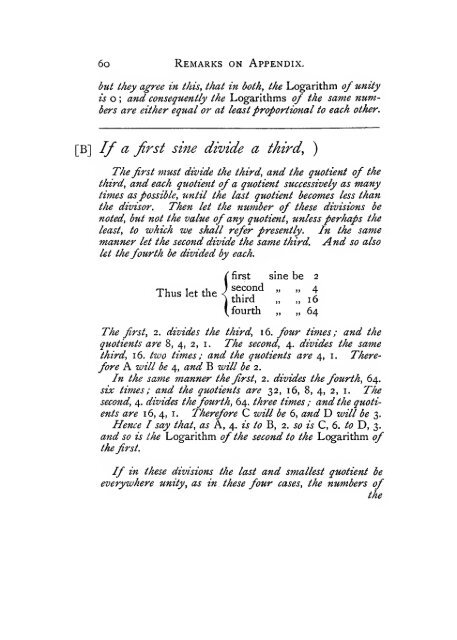

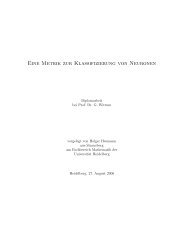
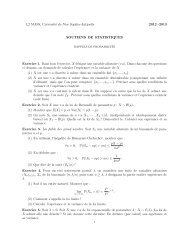
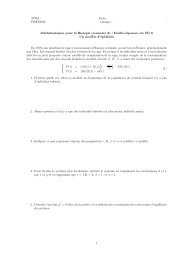


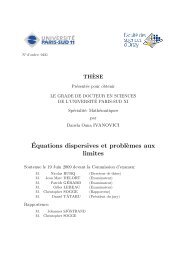
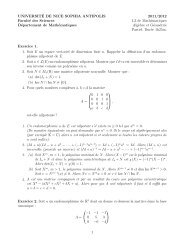
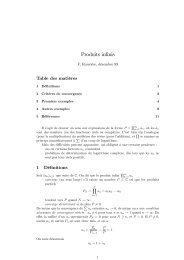
!['eries enti\`eres (+ [D78 Th d'Abel angulaire])](https://img.yumpu.com/14067031/1/184x260/eries-entieres-d78-th-dabel-angulaire.jpg?quality=85)

